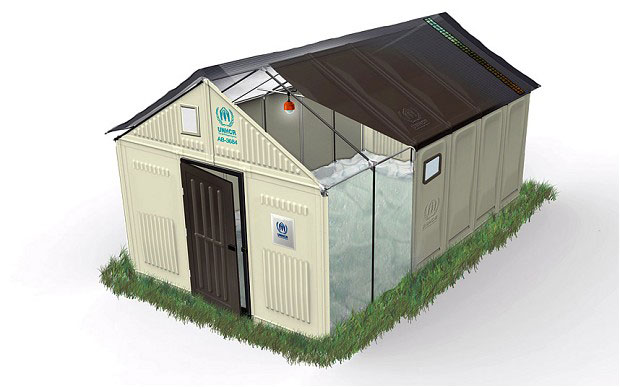
Ikea creates flat packs for refugees
Swedish furniture giant tackles longterm housing for the world's dispossessed
Crisis housing usually comes to us courtesy of some well-meaning architecture undergraduates, or some established firm’s pro-bono work. With the exception of Shigeru Ban's work (see our story left) rarely do even the most ingenious of refugee shelters, flood-resistant dwellings or temporary housing get further than prototype stage. Frankly, the economics are stacked against them. Even a cheaply-made shelter has to find funding, and no one expects the end user – the victims of the latest disaster - to foot the bill.
Which is why the United Nations is still distributing canvas tents. This is bad news for the 43 million people who are either refugees or ‘internally displaced’ in their own countries. Around 80% of those are women and children, and many can be in limbo for more than a decade. The UN’s tents, which currently house around 3.5m people are not ideal. They start to disintegrate after about six months. According to Per Heggenes, CEO of the IKEA Foundation, the tents “offer little comfort, dignity, or security”, adding that they are “cold in the winter and hot in the summer. They have no electricity or lighting, limiting refugee families’ ability to lead a normal life.”
{media1}
So it’s surely good news that those masters of cheap, flat-packed mass production have stepped in. The IKEA Foundation and the United National High Commissioner for Refugees have unveiled a build-it-yourself house with a pitched roof that generates electricity. At 17.5m square, it’s double the size of the UN’s tent, and can accommodate five people. It’s made of a lightweight plastic on a steel frame and can be put up in four hours.
“It is important that the shelter is lightweight enough so that it can be easily and cost efficiently transported, but strong enough to withstand the harsh conditions of refugee camps,” says Johan Karlsson, project manager at Refugee Housing Unit, which is manufacturing the design. "The design is to balance the mechanical properties such as UV, structural strength, insulation, cost and a very specific requirement for this application: privacy."
{media2}
The shelters are being trialled in Ethopia next month (August). At the moment they have a price tag of $10,000 a piece. But that should drop to less than a tenth of that price once they’re in mass production. At $500, those canvas tents cost half that, but the IKEA shelter’s life-span of five years makes them a more cost effective longterm proposition.
As we mentioned in the intro, Shigeru Ban is one architect who's carved out a name for creating innovative and effective disaster housing. You can find out more about his groundbreaking work in our monograph. As one of the foremost creators of 'green' architecture, Ban works with recyclable, affordable, natural materials. These are reflected in the unique design of the book which reflects on his experiments with paper. Take a closer look here.